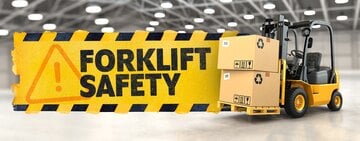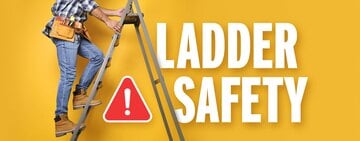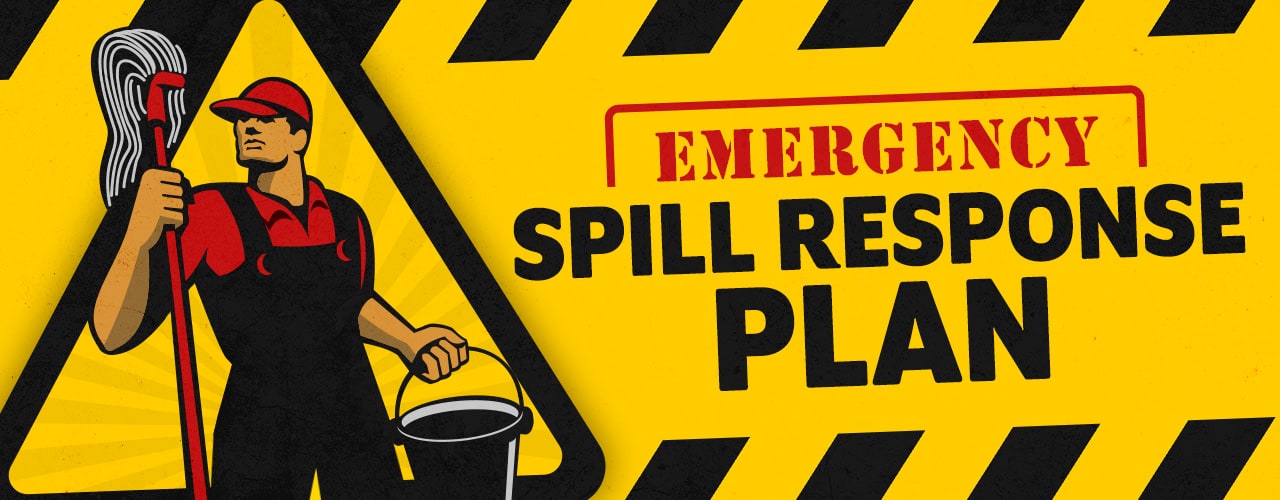
Working with hazardous materials has the potential to be dangerous, making it important that the proper response plans are in place. In the event of an emergency, proper emergency spill response can contain spills from spreading and prevent more damage. If your warehouse works with any type of hazardous substance, you need an emergency spill response plan in place to protect your warehouse employees and equipment. Below, we cover the hallmarks of a strong emergency spill response plan and how you can train your employees in emergency spill response.
Looking for spill containment supplies? Click Below!
Shop All Spill Containment SuppliesOSHA Spill Response Plan
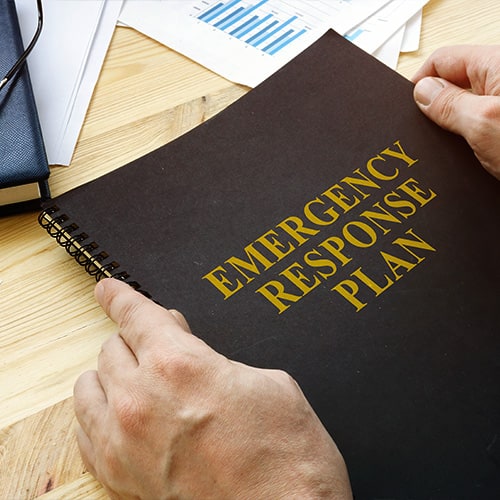
OSHA requires that employers develop a written health and safety program for employees who work with hazardous materials. According to OSHA, these programs should be designed to “identify, evaluate, and control safety hazards, as well as provide emergency response for hazardous waste operations.” To accomplish these goals, spill response plans will consist of the following four steps:
1. Communication
A strong spill emergency plan begins with good communication and effective immediate response. When a spill occurs, workers should quickly notify others and contact the acting supervisors. For more serious spills, emergency services may need to be called and the immediate area evacuated. In scenarios like this, it is recommended that a well-trained staff member takes charge of both the evacuation and coordination with first responders.
2. Control
After the presence of a spill has been communicated, the next step is to get the situation under control. Before any action is taken, workers should be wearing personal protective equipment to minimize the potential of injury. For more protection, increase the ventilation and eliminate sources of heat in the spill area. Doing so disperses toxic fumes and prevents ignition. Once the area is safe and secure, workers can control the situation through actions such as closing an open valve or fixing spilled containers.
3. Containment
Once the source of the spill is under control, staff should work to ensure the spill doesn’t spread to other areas. Areas such as floor drains and vents should immediately be covered to prevent spills from reaching other locations. Absorbents and other neutralizers need to be spread around the edges of the spill, preventing it from spreading outwards. Spill areas should also be blocked off during containment to protect other employees.
4. Clean Up
To clean up an emergency spill, utilize your neutralizers from the edge of the spill, cleaning towards the middle. Absorbents used to clean the spill need to be disposed of as hazardous material. Additionally, any protective equipment or cleaning equipment used during the spill should be properly disposed of as well.
Spill Response Training
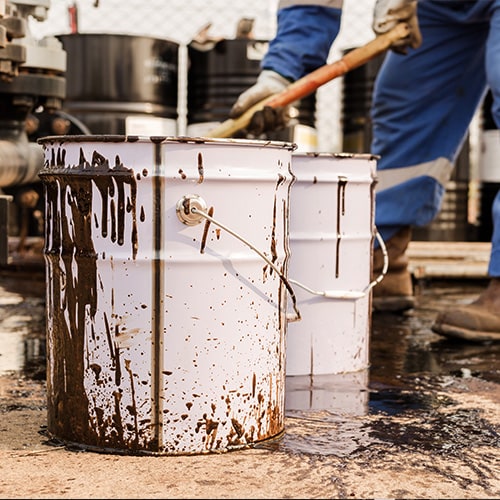
In order to ensure a safe work environment, employees should be trained in emergency spill response. Spill response training provides workers with the knowledge of what to do in case of emergencies, limiting the spread of a spill. OSHA classifies spill response training into five categories, with each having different levels of knowledge and responsibilities in spill response. Here are the different classifications of spill response training and how each type can help in responding to an emergency spill:
1. Hazmat First Responder Awareness
Staff at the awareness level are defined as employees who have the ability to recognize a hazardous spill and have been trained to initiate the proper emergency protocols. Although these people are able to identify hazardous spill emergencies, they take no further action beyond notifying the proper authorities. Staff members at this level of training should be able to identify hazardous materials and the risks they pose, while also knowing the proper chain of command for dealing with emergencies.
2. Hazardous Materials First Responder Operations
In order for staff to be considered at the first responder operations level, they need to know how to immediately respond to hazardous spill emergencies. These employees should know how to contain the spill of hazardous materials from a safe distance, preventing further spread. To do this, first responders at the operational level need to have a basic understanding of hazard control and decontamination procedures, which can be achieved in around eight hours of training.
3. Hazardous Materials Technician
To become a hazardous materials technician, one must undergo at least 24 hours of training and have competency in containment and decontamination procedures. Hazardous materials technicians aggressively combat the spread of hazardous material, directly confronting a spill to prevent more hazardous waste from being released. These staff members should also have a strong understanding of your emergency response plan, being able to calmly implement the plan in the face of an emergency.
4. Hazardous Materials Specialist
Hazardous materials specialists are instructed to assist technicians with containment and decontamination. Specialist-level employees perform similar functions to technicians but are expected to have more specific knowledge about individual hazardous materials. Specialists can also serve as a liaison to government authorities, serving as a direct contact when emergencies occur. Due to their high status, hazardous materials specialists should have the 24-hour specialist training complete and must also be able to lead and execute pre-determined emergency plans.
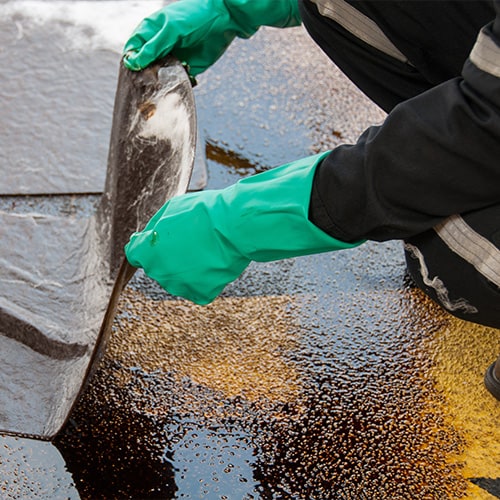
5. On Scene Incident Commander
An on-scene incident commander is a designated staff member who will assume control of emergency response once an incident has been reported. These staff members need to have knowledge of the company, local, and state emergency response plans, as well as be able to implement these strategies in a quick and effective manner. Due to their importance in emergency spill response, on-scene incident commanders need to have well over 24 hours of training.
Back to TopWhat Is Hazardous Waste?
Hazardous waste is defined as any waste that has the potential to harm humans or the environment. Hazardous waste can have a variety of dangerous features such as being toxic, corrosive, or easily flammable. This type of waste needs to be discarded properly, as spills of hazardous material pose a massive threat to public health. When working with any type of hazardous material, staff should be well-trained and prepared for emergency spill response to mitigate potential damages.
Types of Hazardous Waste
There are several different types of hazardous waste, each with characteristics that pose a threat to public health. Some hazardous waste can lead to massive explosions, while others may contaminate the air. Here are some of the most common types of hazardous waste and how they can impact their surroundings:
- Flammable Waste - Flammable hazardous waste is easily ignitable and can lead to fires.
- Toxic Waste - Hazardous waste that is deemed toxic can cause major injury when digested or inhaled.
- Corrosive Waste - Major damage to the skin and eyes can be caused if they come in contact with corrosive hazardous waste. Corrosive waste can also cause material and property damage if left unchecked.
- Explosive Waste - Explosive hazardous waste is volatile and easily detonable, making it extremely dangerous.
- Environmental Waste - Any hazardous material that contaminates water or lowers air quality is known as an environmentally hazardous material.
What Is a Spill Kit?
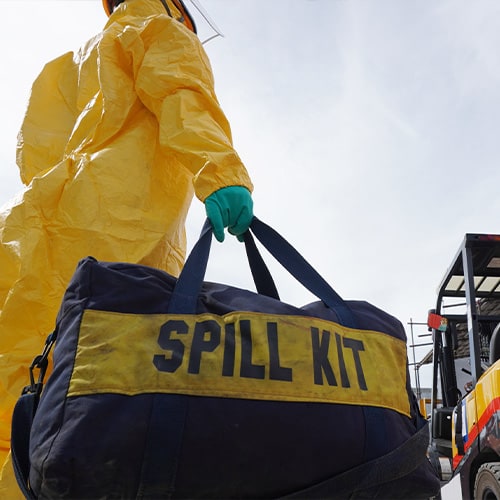
A spill kit is a designated selection of equipment designed to aid in the cleanup of hazardous materials. Spill kits are made so that workers can quickly and safely respond to spills, allowing for efficient response. These kits vary depending on the location and intended purpose, as different spill kits are designed to handle different types of hazardous spills. If hazardous chemicals are present, spill kits should always be on hand so staff can respond in a quick and safe manner.
Spill Kit Box Items
Spill kits can contain a variety of different materials depending on what type of hazardous materials are being worked with. While there is no specific requirement for what a spill kit needs to contain, there are a handful of common items that will make responding to spills an easier task. Here are some items that are frequently found within spill kits:
- PPE equipment - Protective equipment like goggles, gloves, and aprons help protect staff during spill cleanups.
- Absorbents - Absorbents are used to mop up dangerous chemicals and neutralize their negative effects.
- Disposable bags - Used and contaminated PPE equipment should be discarded in disposable bags.
- Acid neutralizers - Neutralizers like baking soda help mitigate the damage caused by acid spills.
- Buckets - Spill and absorbent residue can be safely stored in buckets and pails.
How Should Spill Cleaning Materials Be Discarded?
Due to potential contamination, spill-cleaning materials should always be discarded as hazardous waste. This means that materials like absorbents and cleaning equipment need to be stored and packaged for hazardous waste disposal. Once packaged, the cleaning supplies should then be transported to a hazardous waste disposal facility to be taken care of.
A strong spill response plan has the potential to protect employees from harm and save thousands of dollars in damages. If working with hazardous materials, you need to have an extensive plan in place in the event of a spill. Not only does this plan need to be clearly outlined, but staff must also be well-trained on how to enact it. An emergency spill response plan could be the difference between a small spill and a major accident.




